About the Church
 |
 |
 |
 |
 |
 |
 |
The Holy Mass - Part XVI
Mass of the Faithful:
From the Ablutions to the Last Gospel
One of the greatest contrasts in atmosphere between the Novus Ordo Mass and the Tridentine Mass can be seen at the Communion and Post-Communion.
At the Novus Ordo the people queue up to receive the Host in the hand, and perhaps stop at the wine corner where a bevy of women are the ministers. Almost everyone is joyful and
often boisterously singing, songs that do not stop until Communion finishes.
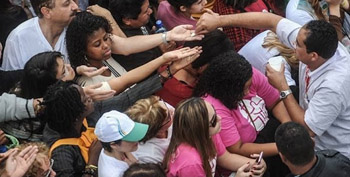
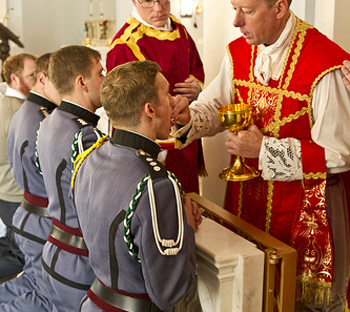 At the Latin Mass, the lines for Communion are silent; the communicants are serious, recollected and silent, kneeling reverently at the altar rail with hands folded beneath the altar cloth. Returning to the pew, the communicant trains himself to look inward rather than outward, contemplating the great gift he has just received.
At the Latin Mass, the lines for Communion are silent; the communicants are serious, recollected and silent, kneeling reverently at the altar rail with hands folded beneath the altar cloth. Returning to the pew, the communicant trains himself to look inward rather than outward, contemplating the great gift he has just received.
Some powerful prayers with special indulgences recommended for after Communion are the Anima Christi, (Soul of Christ, sanctify me..), the Prayer before the Crucifix En ego, o bone et dulciccime Jesu...), and the Magnificat (My soul doth magnify the Lord...).
The ablutions
As the congregation prays silently, the priest performs the ablutions, or washings. This impressive ceremony – which has been so simplified as to be unrecognizable in the Novus Ordo Mass – forcibly emphasizes the great respect the priest and the faithful have for the Real Presence. In the New Mass often it is not even the priest, but a server or Eucharistic minister who makes what they now call the “purification”:
After Communion it is prescribed that the priest shall carefully gather with great diligence any particles of the Sacred Host from the corporal and the paten and place them into the chalice.
The priest takes the chalice and pours wine into it. Then the priest drinks it and says quietly: "Quod ore súmpsimus" (Grant, O Lord) ...
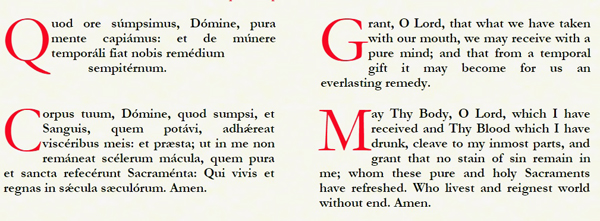
Now comes another washing, or the second ablution.
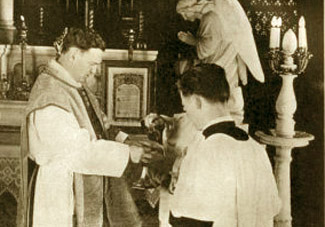
Wine and then water are poured into the chalice over the priest's fingers. As he dries them, he says quietly: Corpus tuum, Dómine, (May Thy Body, O Lord)..."
The priest always drinks the mingled wine and water from the same side of the chalice; for this reason a small cross is engraved on its foot.
This ceremony comes from the early centuries of the Church. We know that St. Cyril of Jerusalem impressed on communicants how important it was that not even the smallest particle of the Body of Our Lord should be lost or scattered. "Let not one single crumb of that which is much more precious than gold or gems escape you," he instructs.(1)
Post- Communion
This solemn ceremony finished, the priest recites the Communion Antiphon and says the Dominus vobiscum. Then, he recites the final prayer, which is called the Post-Communion in our missals, but which, in the Sacramentary of St. Gregory, was designated the Oratio ad complendum, referring to the completion of the sacrifice.
The prayer, which varies, petitions for blessings, both natural and supernatural, as suggested by the feast day or the liturgical season.
Ite Missa est, Placeat & blessing
The next Dominus vobiscum is another expression of thanks for the great blessing conferred in applying the merits of the Blood of Christ to those present. "There is nothing shorter and at the same time grander than this act of thanksgiving," says St. Augustine.(2)
Then, the dismissal, the blessing and the Last Gospel come. In the early Church, the Ite Missa est ended the divine worship, as it was the Roman custom to close any public assembly with a formal dismissal. Many persons do not realize that this is where the name we now use for the Holy Sacrifice originated. In the mind of the early Christian this dismissal was something so formal, necessary and significant that it led to the name Missa, Mass. (3)

The dismissal made, the priest turns again to the altar and, bowing somewhat with his hands joined, says the Placeat tibi...

This prayer, says Dom Gueranger, is a kind of epitome made by the priest, beseeching the Holy Trinity to accept the sacrifice he has offered and reminding himself to examine his conscience to see how he has celebrated the Holy Sacrifice.
Benedicat vos
After this prayer, the priest kisses the altar, raises his eyes to Heaven, stretches out his hands and bows before the Cross, saying Benedicat vos omnipotens Deus. Then, turning round to the people he blesses them and says, Pater, et Filius et Spiritus Sanctus.

This blessing of the Triune God is the farewell benediction of the Father bestowed on His children present, who are about to go out into the world and engage in their daily labor.
The Last Gospel
The Blessing having been given, the priest goes to the Gospel side of the altar and there reads the beginning of the Gospel according to St. John.
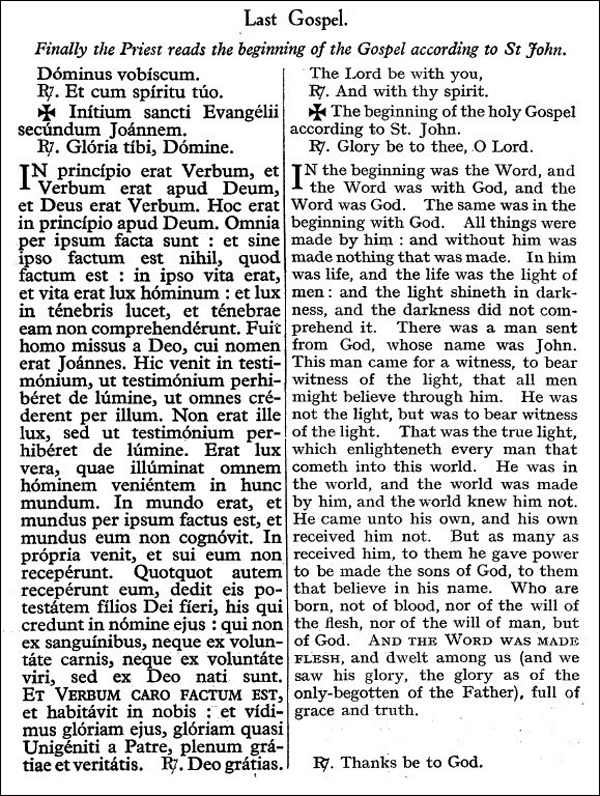 .
.
This reading originated from the Middle Ages: The practice started at the request of the people, who wanted to have the priest read a Gospel over them at the end of the Mass.
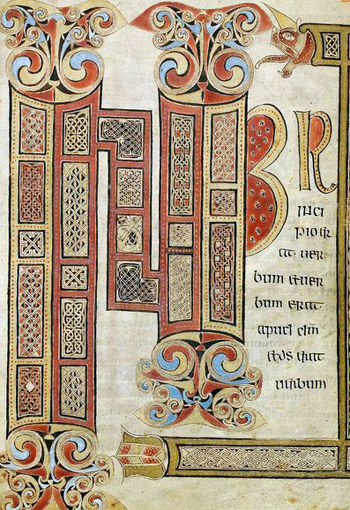 The Gospel of St. John was a favorite as it was considered a kind of exorcism. So, this prologue was accorded the efficacy of a sacramental and the priests returning from the altar often recited it at the request of the faithful as a protection against all evils.
The Gospel of St. John was a favorite as it was considered a kind of exorcism. So, this prologue was accorded the efficacy of a sacramental and the priests returning from the altar often recited it at the request of the faithful as a protection against all evils.
This Gospel was adopted into the liturgy of the Mass at the time of St. Pius V. It was the devotion of the faithful alone, Dom Gueranger notes, that originated this addition.(4)
It is fitting , therefore, that the faithful kneel together with the priest at the words Et Verbum caro factum est (And the Word was made flesh), for these words have been verified in the most sublime manner in the celebration of the Holy Mass.
Deo gratias should indeed be the silent response of our grateful hearts.
The next article, which will be the last of this series, will look at the origin of the Leonine prayers and describe several beneficial ways that the faithful can assist at the Holy Mass.
Continued


A free-for-all at the WYD communion; below, reverence and dignity at the communion rail

Some powerful prayers with special indulgences recommended for after Communion are the Anima Christi, (Soul of Christ, sanctify me..), the Prayer before the Crucifix En ego, o bone et dulciccime Jesu...), and the Magnificat (My soul doth magnify the Lord...).
The ablutions
As the congregation prays silently, the priest performs the ablutions, or washings. This impressive ceremony – which has been so simplified as to be unrecognizable in the Novus Ordo Mass – forcibly emphasizes the great respect the priest and the faithful have for the Real Presence. In the New Mass often it is not even the priest, but a server or Eucharistic minister who makes what they now call the “purification”:
After Communion it is prescribed that the priest shall carefully gather with great diligence any particles of the Sacred Host from the corporal and the paten and place them into the chalice.
The priest takes the chalice and pours wine into it. Then the priest drinks it and says quietly: "Quod ore súmpsimus" (Grant, O Lord) ...

Now comes another washing, or the second ablution.

The second ablution
Wine and then water are poured into the chalice over the priest's fingers. As he dries them, he says quietly: Corpus tuum, Dómine, (May Thy Body, O Lord)..."
The priest always drinks the mingled wine and water from the same side of the chalice; for this reason a small cross is engraved on its foot.
This ceremony comes from the early centuries of the Church. We know that St. Cyril of Jerusalem impressed on communicants how important it was that not even the smallest particle of the Body of Our Lord should be lost or scattered. "Let not one single crumb of that which is much more precious than gold or gems escape you," he instructs.(1)
Post- Communion
This solemn ceremony finished, the priest recites the Communion Antiphon and says the Dominus vobiscum. Then, he recites the final prayer, which is called the Post-Communion in our missals, but which, in the Sacramentary of St. Gregory, was designated the Oratio ad complendum, referring to the completion of the sacrifice.
The prayer, which varies, petitions for blessings, both natural and supernatural, as suggested by the feast day or the liturgical season.
Ite Missa est, Placeat & blessing
The next Dominus vobiscum is another expression of thanks for the great blessing conferred in applying the merits of the Blood of Christ to those present. "There is nothing shorter and at the same time grander than this act of thanksgiving," says St. Augustine.(2)
Then, the dismissal, the blessing and the Last Gospel come. In the early Church, the Ite Missa est ended the divine worship, as it was the Roman custom to close any public assembly with a formal dismissal. Many persons do not realize that this is where the name we now use for the Holy Sacrifice originated. In the mind of the early Christian this dismissal was something so formal, necessary and significant that it led to the name Missa, Mass. (3)

The dismissal made, the priest turns again to the altar and, bowing somewhat with his hands joined, says the Placeat tibi...

This prayer, says Dom Gueranger, is a kind of epitome made by the priest, beseeching the Holy Trinity to accept the sacrifice he has offered and reminding himself to examine his conscience to see how he has celebrated the Holy Sacrifice.
Benedicat vos
After this prayer, the priest kisses the altar, raises his eyes to Heaven, stretches out his hands and bows before the Cross, saying Benedicat vos omnipotens Deus. Then, turning round to the people he blesses them and says, Pater, et Filius et Spiritus Sanctus.

This blessing of the Triune God is the farewell benediction of the Father bestowed on His children present, who are about to go out into the world and engage in their daily labor.
The Last Gospel
The Blessing having been given, the priest goes to the Gospel side of the altar and there reads the beginning of the Gospel according to St. John.
 .
.This reading originated from the Middle Ages: The practice started at the request of the people, who wanted to have the priest read a Gospel over them at the end of the Mass.

An illuminated page of the Last Gospel
This Gospel was adopted into the liturgy of the Mass at the time of St. Pius V. It was the devotion of the faithful alone, Dom Gueranger notes, that originated this addition.(4)
It is fitting , therefore, that the faithful kneel together with the priest at the words Et Verbum caro factum est (And the Word was made flesh), for these words have been verified in the most sublime manner in the celebration of the Holy Mass.
Deo gratias should indeed be the silent response of our grateful hearts.
The next article, which will be the last of this series, will look at the origin of the Leonine prayers and describe several beneficial ways that the faithful can assist at the Holy Mass.
Continued
- Daniel Rock, Hierurgia, or, Transubstantiation, invocation of saints, relics, and Purgatory, London:C Dolman, LONDON: C Dolman, 1951.pp. 109-110
- Saint Andrew Daily Missal, 1954 ed., p. 987.
- Dom Prosper Guéranger, Explanation of the Holy Mass, Loreto Publications, 2007, pp. 198-99
- Ibid., p. 202

Posted February 1, 2018















